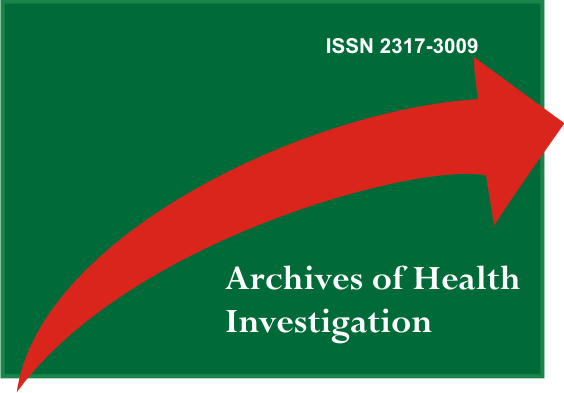Failure rate of pterygomandibular block in lower third molar extraction procedures
DOI:
https://doi.org/10.21270/archi.v7i9.3149Resumen
The aim of this study was to evaluate the anaesthetic failure rate of the pterygomandibular technique with an inferior alveolar nerve block in lower third molar extraction procedures. Materials and Methods: A total of 67 healthy patients (men and women, aged between 18–35 years) requiring third molar extractions were selected from the Discipline of Surgery, of the Araçatuba Dental School. The anaesthetic technique utilised was a pterygomandibular block using 2% mepivacaine hydrochloride with epinephrine 1:100,000 (Mepivalem®) in a maximum standardised amount of three tubes (5.4 ml) per procedure (performed by the same operator). Surgical procedures were initiated after confirming the sensation of anaesthesia in the area anesthetised at the inferior alveolar nerve. Painful symptoms were recorded during surgery. Results: In total, 117 surgical procedures, i.e., 114 exodontias and three coronectomies, were performed. During surgical procedures, four patients reported pain during manoeuvres of odontosection, representing an anaesthetic failure rate of 3.41%. Alternative techniques utilised in these four patients involved milohioideo nerve, intraligamentaria, and intrapulpal anaesthesia. Conclusion: The success of inferior alveolar nerve block anaesthesia is difficult to predict due to large anatomical variations, and it is difficult to observe via diagnostic means. The relatively low percentage of anaesthetic failure reported in this study may be related to the number of procedures performed.Descriptors: Anesthesia, Dental; Anesthesia, Local; Molar, Third.
Descargas
Citas
Johnson TM, Badovinac R, Shaefer J. Teaching alternatives to the standard inferior alveolar nerve block in dental education: outcomes in clinical practice. J Dent Educ. 2007; 71(9):1145–52.
Giovannitti JA Jr., Rosenberg MB, Phero JC. Pharmacology of local anesthetics used in oral surgery. Oral Maxillofac Surg Clin North Am. 2013; 25(3):453-65.
Ueno T, Tsuchiya H, Mizogami M, Takakura K. Local anesthetic failure associated with inflammation: verification of the acidosis mechanism and the hypothetic participation of inflammatory peroxynitrite. J Inflamm Res. 2008; 1:41-8.
Nusstein JM, Reader A, Drum M. Local anesthesia strategies for the patient with a "hot" tooth. Dent Clin North Am. 2010; 54(2):237-47.
Rood JP. Some anatomical and physiological causes of failure to achieve mandibular analgesia. Br J Oral Surg. 1977; 15(1):75-82.
Boronat López A, Peñarrocha Diago M. Failure of locoregional anesthesia in dental practice. Review of the literature. Med Oral Patol Oral Cir Bucal. 2006; 11(6):E510-13.
Lew K, Townsend G. Failure to obtain adequate anaesthesia associated with a bifid mandibular canal: a case report. Aust Dent J. 2006; 51(1):86-90.
Yonchak T, Reader A, Beck M, Meyers WJ. Anesthetic efficacy of unilateral and bilateral inferior alveolar nerve blocks to determine cross innervation in anterior teeth. Oral Surg Oral Med Oral Pathol Oral Radiol Endod. 2001; 92(2):132-35.
Pilar R-SMd. Manejo de Accidentes y
complicaciones en cirugia dentoalveolar. Bogotá: Entereditores; 2008.
Holliday R, Jackson I. Superior position of the mandibular foramen and the necessary alterations in the local anaesthetic technique: a case report. Br Dent J. 2011; 210(5):207-11.
Blanton PL, Jeske AH. The key to profound local anesthesia: neuroanatomy. J Am Dent Assoc. 2003; 134(6):753-60.
Kanaa MD, Whitworth JM, Meechan JG. A prospective randomized trial of different supplementary local anesthetic techniques after failure of inferior alveolar nerve block in patients with irreversible pulpitis in mandibular teeth. J Endod. 2012; 38(4):421-25.
Vinckier F. What is the cause of failure of local anesthesia? Rev Belge Med Dent (1984). 2000; 55(1):41-50.
Wong MK, Jacobsen PL. Reasons for local anesthesia failures. J Am Dent Assoc. 1992; 123(1):69-73.
Clark S, Reader A, Beck M, Meyers WJ. Anesthetic efficacy of the mylohyoid nerve block and combination inferior alveolar nerve block/mylohyoid nerve block. Oral Surg Oral Med Oral Pathol Oral Radiol Endod. 1999; 87(5):557-63.
Meechan JG. Supplementary routes to local anaesthesia. Int Endod J. 2002; 35(11):885-96.


